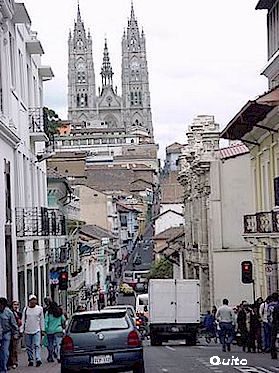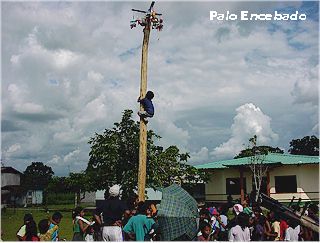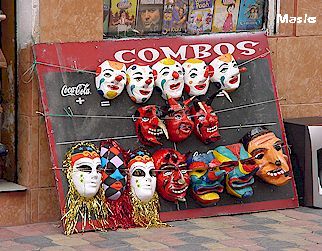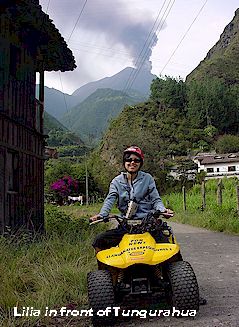Travel E-Logs: Amazon Rain Forest
Dear students:
ISaludos desde la selva lluviosa de Ecuador! Lilia and I are in the rain forest now, on our way (via a twelve hour overnight bus ride) to Limoncocha, a town where we both previously taught. We’ll be spending the next two weeks visiting schools in and around Limoncocha.
A Ring of Volcanoes, High Above the Amazon
 We
started our trip three weeks ago in Quito, the capital of Ecuador, in the
Andes mountains (just west of and far above the Amazon rain forest). Can you
locate Quito and the Andes on the map? As I mentioned last time, the Andes
run up and down the whole western coast of South America. In the north, they
tower over the Amazon which begins at their base to the east. Quito is located
in a long narrow valley that runs north-south between two mountain ranges.
This valley is sometimes referred to as Volcano Alley since a ring of nine
active volcanoes surrounds the city. (Active doesn't mean that they are erupting
right now, but that there is still potential for them to erupt at some point
in the future. Ecuador has a total of 31 active volcanoes, including some
in the Galapagos Islands.)
We
started our trip three weeks ago in Quito, the capital of Ecuador, in the
Andes mountains (just west of and far above the Amazon rain forest). Can you
locate Quito and the Andes on the map? As I mentioned last time, the Andes
run up and down the whole western coast of South America. In the north, they
tower over the Amazon which begins at their base to the east. Quito is located
in a long narrow valley that runs north-south between two mountain ranges.
This valley is sometimes referred to as Volcano Alley since a ring of nine
active volcanoes surrounds the city. (Active doesn't mean that they are erupting
right now, but that there is still potential for them to erupt at some point
in the future. Ecuador has a total of 31 active volcanoes, including some
in the Galapagos Islands.)
Four years
ago when I visited Quito, one of its volcanoes exploded, sending a huge cloud
of smoke over the city and showering ash down upon it. Schools were closed
for several days. (So, though they never have snow days in Quito, they sometimes
have ASH days!) Fortunately, the mountain, known as Guagua Pichincha,
calmed down before it spewed any lava and has not rumbled since. Last year,
when Lilia and I were in Quito, everyone in the city was sweeping up ash
from another volcanic eruption. Reventador, a volcano on the edge of
the Amazon, exploded and sent ash raining down on Quito, over 60 miles away!
The Andes mountains are very tall. Some are snow-capped all year round even though they practically straddle the equator. To give you an idea of how tall they are, Guagua Pichincha (which is not even tall enough to have snow like several other mountains in Ecuador) is 15, 840 feet high, exactly three miles above sea level! In comparison, the tallest mountain in New York (where I'm from), Mount Marcy, is only 5,344 feet (a little over a mile) above sea level.
(NOTE: While in Quito, Lilia and I took many photos of the city’s art and architecture. We are putting together a Web site called Tur de Quito: Arte y Arquitectura which we will post on the project Web site before the end of the project.)
Flashback
As I mentioned in the first travel log, Lilia and I also traveled to Limoncocha in December before our project began. We attended several Christmas festivals. One interesting game that is played during the Christmas festival is called palo encebado (slippery pole). I wrote a description of palo encebado, along with an explanation of how palo encebado helps teach children an important rain forest skill, in an E-Travel Log that I sent to schools last year. Here it is:
==========================
Palo Encebado en la Fiesta (Slippery Pole in the Festival)
At dusk on the evening of the Christmas fiesta, a man cut down a small balsa tree with his machete and cut it again to make a pole 18 feet long. He peeled off the first ten feet of bark, leaving the rest as it was. Under the bark, the wood is moist and very slippery; but the bark itself, once moistened, is slipperier still. Next he attached two two-foot long sticks to the top of the pole, making an X. From the sticks, he strung twenty pieces of string and attached a small toy to each. Then, he dug a hole about three feet deep, put the peeled end of the pole into it and covered the hole again. By this time, all the children in the village had gathered around the pole and all the adults had gathered around the children, for it was time to play the game.
Another man,
a teacher, had the children who were ten or under form two lines, one with
boys and one with girls. Most of the children wore long-sleeved shirts and
long pants or long socks to get a better grip, and some wore socks on their
arms. One at a time, the teacher lifted the children up to the pole. Th ey
wrapped their arms and legs around it and then tried to scooch their way up
to where the toys were. If they could reach the top, fifteen feet up, they
got to snatch one of the toys for keeps.
ey
wrapped their arms and legs around it and then tried to scooch their way up
to where the toys were. If they could reach the top, fifteen feet up, they
got to snatch one of the toys for keeps.
The first climber snuggled his way up about seven feet, tried in vain to continue and, schwooooooop, slipped back down to the laughter of the crowd. The next climber just hugged the pole for a while, wearing a big smile, then let go, and the crowd laughed again. At one point, one of the boys lost his pants on the way up - and that got the loudest laugh of the night. For the whole first round, not a single child made it past the peeled part of the pole. But, with each climber, the pole got a little drier, the children climbed a little higher and the crowd got a little more excited. By round three, the climbers were plucking presents to the cheers of the onlookers.
Everyone, spectators and participants alike, had a great time. Even if a climber didn't get a present, he or she still laughed and had lots of fun.
Uvas de los Arboles (Tree Grapes)
Two days
after the festival, when some students of mine asked me to pick uvas del
monte (forest grapes) with them, I realized that besides being so much
fun, palo encebado also teaches a very important rain forest skill -- tree
climbing. Now is the time of year when children can 'pick candy from the trees'--sort
of. The guavanilla tree produces thousands and thousands of dark green eight-inch
 pods
with about ten seeds each. Around each seed is a moist, cotton-like, fluffy
white coating that is very sweet. To rain forest children, guavanillas and
their much larger cousins, guavas (not the same as guava in English which
is guayabana in Spanish), are like tree candy. Forest grapes, named after
their resemblance to regular grapes, are too. They grow in bunches of several
hundred way at the top of tall rain forest trees, so they're a bit more challenging
to reach than regular grapes. But, if you grew up playing palo encebado,
you'd have no problem getting to them.
pods
with about ten seeds each. Around each seed is a moist, cotton-like, fluffy
white coating that is very sweet. To rain forest children, guavanillas and
their much larger cousins, guavas (not the same as guava in English which
is guayabana in Spanish), are like tree candy. Forest grapes, named after
their resemblance to regular grapes, are too. They grow in bunches of several
hundred way at the top of tall rain forest trees, so they're a bit more challenging
to reach than regular grapes. But, if you grew up playing palo encebado,
you'd have no problem getting to them.
Marco, the oldest in the group of grape harvesters I went picking with, climbed the tallest uva tree, some ninety feet high. Before climbing, his cousin, Sofia, using her machete, cut some stems and leaves from several young lianas, palm trees with leaves large enough to hide a person behind that fold open like a fan. Meanwhile, Marco's sister, Ana Maria, cut a long thin branch from a nearby tree. Marco took the palm stems, broke them in several places, and peeled off the skin-like bark, making several belt-like strips.
He tied the ends of the strips together to make a loop and attached to the loop to his right foot. Then, using two small thin trees with trunks only a few inches in diameter that were leaning up against the great trunk of the uva tree, he climbed about twenty five feet up to where the uva tree split into several large branches. From there, he put both his feet inside the loop, wrapped his arms around a large branch palo encebado style, and climbed straight up, using the loop between his feet as a brace each time he went further up. Once near the top, where there were lots of smaller branches to grab a hold of, he didn't need the loop.
As Marco climbed, Sofia took some liana leaves, tore them into strips and used them to tie two small sticks to one end of the long pole that Ana Maria had cut, making a picking tool for Marco. Ana Maria then climbed a nearby tree and passed the tool to Marco way up in the uva tree. Marco grabbed as many bunches of 'grapes' as he could reach without using the pole first, then used the pole to pull lots more branches and bunches of grapes to him. Once he started getting grapes, Ana Maria climbed a smaller uva tree, with the assistance of another cousin, Gricelda, and picked even more.
My job was to catch the bunches of grapes as Marco tossed them down to me -- and my tool was a big round basket. Marco's cousin, Kendy, the youngest in our group, picked big dried uva leaves from the ground and filled my basket with them, to break the fall of the bunches of grapes. As the grapes landed in the basket, the dried leaves crumbled and, after every few bunches, Kendy, put more leaves in. Marco's aim was very true, no matter which angle he tossed the grapes from, so my job was easy.
New Year’s Celebrations in Baños
 After
spending Christmas in Limoncocha, Lilia and I traveled back up into the mountains
to a beautiful town called Baños, famous for its hot thermal baths
and its active volcano, Tungurahua. Five years ago, the people of Baños
had to evacuate because Tungurahua was rumbling and threatened a major
eruption. The town remained vacant for a whole year, but Tungurahua, consistently
smoking and sputtering lava, never blew. Eventually, the Ecuadorian government
allowed the citizens of Baños to return to their town, though the mountain
continues to rumble and smoke and put on a nightly lava fireworks display.
After
spending Christmas in Limoncocha, Lilia and I traveled back up into the mountains
to a beautiful town called Baños, famous for its hot thermal baths
and its active volcano, Tungurahua. Five years ago, the people of Baños
had to evacuate because Tungurahua was rumbling and threatened a major
eruption. The town remained vacant for a whole year, but Tungurahua, consistently
smoking and sputtering lava, never blew. Eventually, the Ecuadorian government
allowed the citizens of Baños to return to their town, though the mountain
continues to rumble and smoke and put on a nightly lava fireworks display.
Lilia and
I spent New Years in Baños. New Year’s there is a little like
Halloween in the U.S. Children wear masks and ask people on the streets for
small  change.
At midnight, people burn Año Viejos, effigies that represent
the old year. If the old year was a bad one, people will kick the effigies
before they burn them. Some people jump over the "Old Year" for
good luck in the new one. Young men dress up (in very funny costumes) as viudas
and beg for money, pretending to be the widow of the "Old Year."
We had fun watching the festivities!
change.
At midnight, people burn Año Viejos, effigies that represent
the old year. If the old year was a bad one, people will kick the effigies
before they burn them. Some people jump over the "Old Year" for
good luck in the new one. Young men dress up (in very funny costumes) as viudas
and beg for money, pretending to be the widow of the "Old Year."
We had fun watching the festivities!
Photos
We are attaching several photos to this report, one of Guagua Pichincha when it erupted four years ago, one of Lilia on a four-wheeler in front of a smoking Tungurahua (taken last wek), one of architecture in Quito, one of a child climbing the palo encebado in the rain forest (taken on Christmas day) and one of New Year’s masks.
Next Time
While in Baños, Lilia and I visited a school called Dr. Misael Acosta Solis for three days. We’ll tell you a little more about Baños and our visit to the school in the next report. After that, we’ll be reporting about Limoncocha and the Amazon.
Till then, learn lots!
Paul Hurteau
Project Director
Amazon Rain Forest School Project
=========================
Teachers: Visit the 'Where to Begin' pages of The ARFS Project Classroom Package to read 'How to Find Limoncocha' and for related activities and links.
Also see
the 'Reading Fun' section for
related reading material.
<><><><><><><><><><><><><><><><><><><><><><><>
| E-Travel Log #1: Introduction to the Project and the Adventure Team |
| E-Travel Log #2: Quito, Banos and Flashbacks of Christmas Celebrations in Limoncocha |
| E-Travel Log #3: Banos - Where the Rain Forest Begins |
| E-Travel Log #4: Limoncocha - A Quichua Community |
| E-Travel Log #5: Limoncocha and Communities Around - Traditions and Cultures |
| E-Travel Log #6: Getting Ready to Leave for Cuyabeno |
| E-Travel Log #7: Rain Forest Animals |
| E-Travel Log #8: Rain Forest Stories and the Mysterious Black Lake |
| E-Travel Log #9: Trip to Playas de Cuyabeno |
| E-Travel Log #10: Trip to San Pablo - a Secoya Community |
